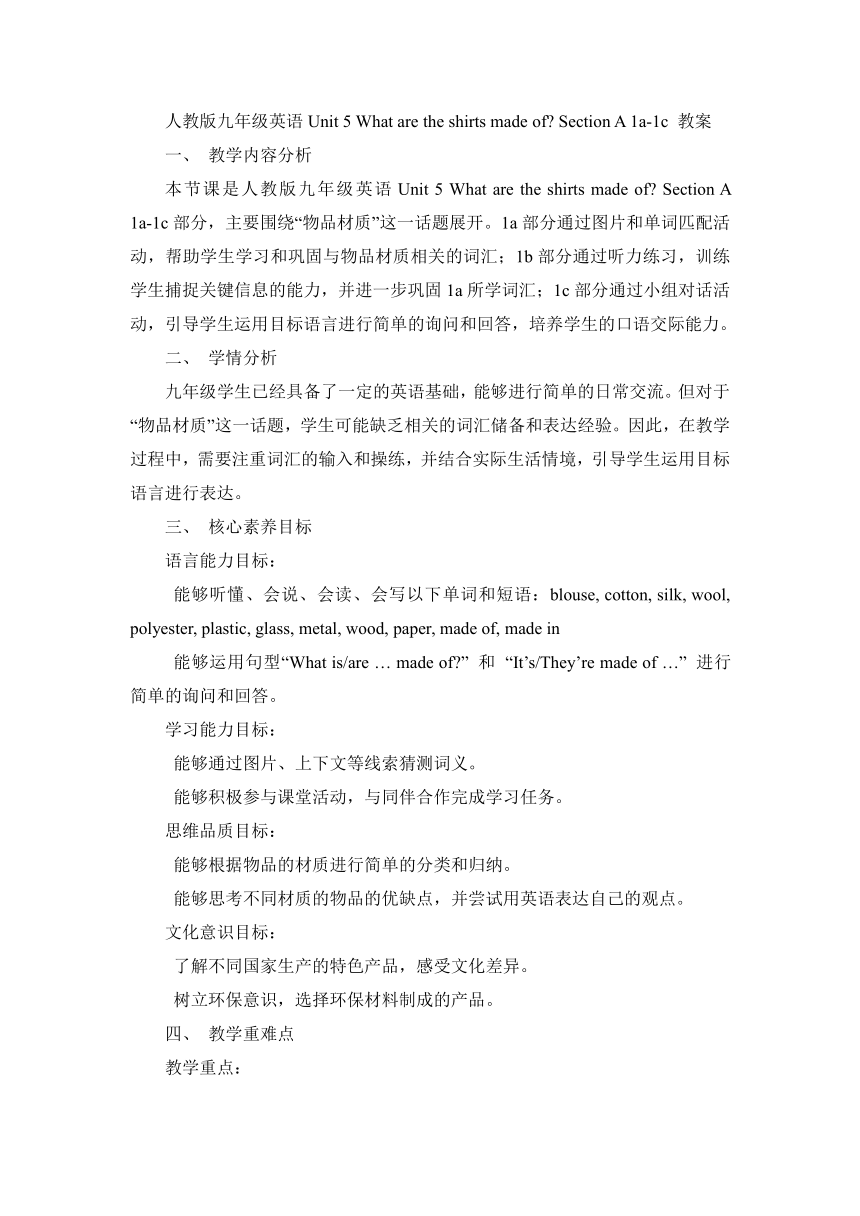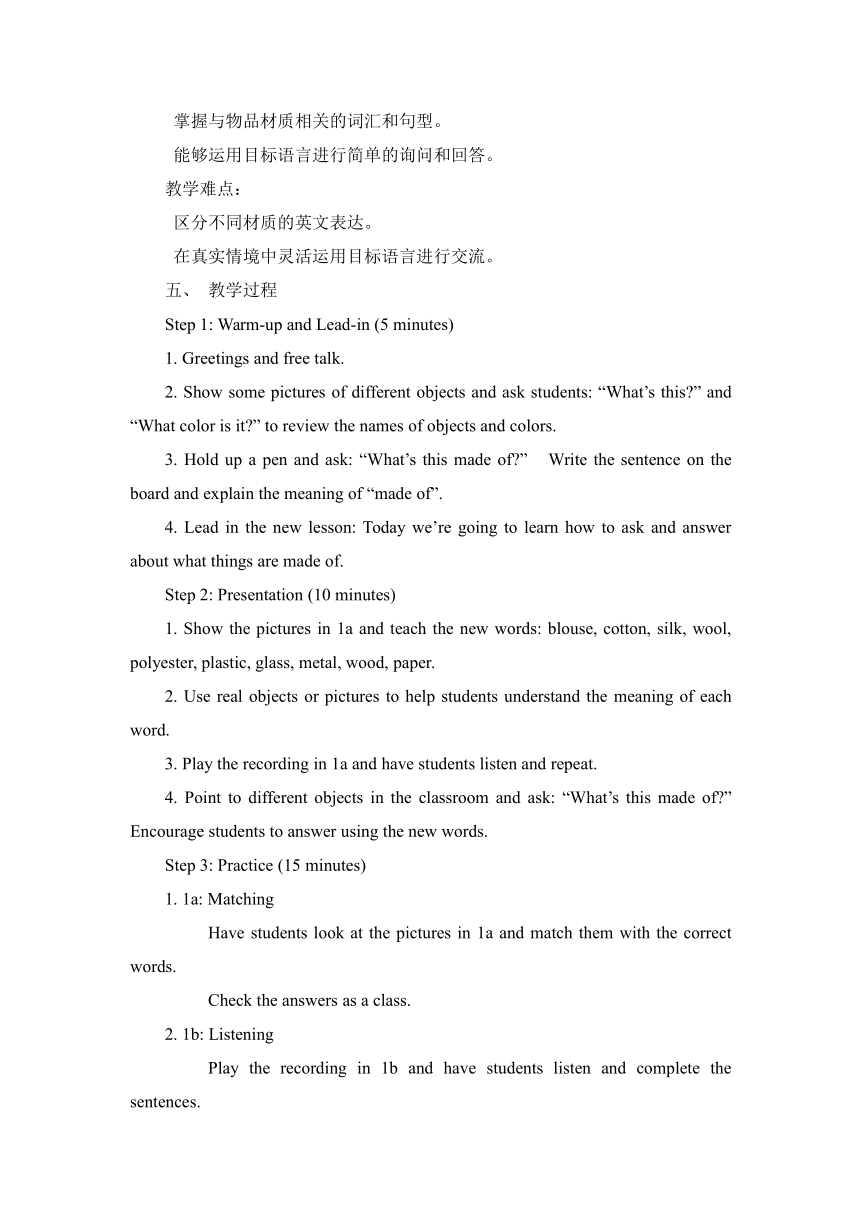人教版九年级英语Unit 5 What are the shirts made of Section A 1a-1c 教案
文档属性
| 名称 | 人教版九年级英语Unit 5 What are the shirts made of Section A 1a-1c 教案 |  | |
| 格式 | doc | ||
| 文件大小 | 25.0KB | ||
| 资源类型 | 教案 | ||
| 版本资源 | 人教新目标(Go for it)版 | ||
| 科目 | 英语 | ||
| 更新时间 | 2025-02-19 10:37:22 | ||
图片预览


文档简介
人教版九年级英语Unit 5 What are the shirts made of Section A 1a-1c 教案
一、 教学内容分析
本节课是人教版九年级英语Unit 5 What are the shirts made of Section A 1a-1c部分,主要围绕“物品材质”这一话题展开。1a部分通过图片和单词匹配活动,帮助学生学习和巩固与物品材质相关的词汇;1b部分通过听力练习,训练学生捕捉关键信息的能力,并进一步巩固1a所学词汇;1c部分通过小组对话活动,引导学生运用目标语言进行简单的询问和回答,培养学生的口语交际能力。
二、 学情分析
九年级学生已经具备了一定的英语基础,能够进行简单的日常交流。但对于“物品材质”这一话题,学生可能缺乏相关的词汇储备和表达经验。因此,在教学过程中,需要注重词汇的输入和操练,并结合实际生活情境,引导学生运用目标语言进行表达。
三、 核心素养目标
语言能力目标:
能够听懂、会说、会读、会写以下单词和短语:blouse, cotton, silk, wool, polyester, plastic, glass, metal, wood, paper, made of, made in
能够运用句型“What is/are … made of ” 和 “It’s/They’re made of …” 进行简单的询问和回答。
学习能力目标:
能够通过图片、上下文等线索猜测词义。
能够积极参与课堂活动,与同伴合作完成学习任务。
思维品质目标:
能够根据物品的材质进行简单的分类和归纳。
能够思考不同材质的物品的优缺点,并尝试用英语表达自己的观点。
文化意识目标:
了解不同国家生产的特色产品,感受文化差异。
树立环保意识,选择环保材料制成的产品。
四、 教学重难点
教学重点:
掌握与物品材质相关的词汇和句型。
能够运用目标语言进行简单的询问和回答。
教学难点:
区分不同材质的英文表达。
在真实情境中灵活运用目标语言进行交流。
五、 教学过程
Step 1: Warm-up and Lead-in (5 minutes)
1. Greetings and free talk.
2. Show some pictures of different objects and ask students: “What’s this ” and “What color is it ” to review the names of objects and colors.
3. Hold up a pen and ask: “What’s this made of ” Write the sentence on the board and explain the meaning of “made of”.
4. Lead in the new lesson: Today we’re going to learn how to ask and answer about what things are made of.
Step 2: Presentation (10 minutes)
1. Show the pictures in 1a and teach the new words: blouse, cotton, silk, wool, polyester, plastic, glass, metal, wood, paper.
2. Use real objects or pictures to help students understand the meaning of each word.
3. Play the recording in 1a and have students listen and repeat.
4. Point to different objects in the classroom and ask: “What’s this made of ” Encourage students to answer using the new words.
Step 3: Practice (15 minutes)
1. 1a: Matching
Have students look at the pictures in 1a and match them with the correct words.
Check the answers as a class.
2. 1b: Listening
Play the recording in 1b and have students listen and complete the sentences.
Check the answers as a class.
Play the recording again and have students repeat the sentences.
3. 1c: Pair work
Divide students into pairs and have them practice the conversation in 1c.
Encourage students to use different objects and materials to make their own conversations.
Invite some pairs to perform their conversations in front of the class.
Step 4: Production (10 minutes)
1. Group work:
Divide students into small groups and give each group a set of pictures of different objects.
Have students ask and answer questions about what the objects are made of.
Encourage students to use the sentence patterns: “What is/are … made of ” and “It’s/They’re made of …”
2. Class survey:
Have students walk around the classroom and ask their classmates about what their clothes, bags, or other belongings are made of.
Encourage students to record their findings and share them with the class.
Step 5: Summary and Homework (5 minutes)
1. Summarize the key points of the lesson: new words, sentence patterns, and how to ask and answer about what things are made of.
2. Homework:
Write a short paragraph about what your favorite object is made of and why you like it.
Find out what some common household items are made of and prepare to share with the class next time.
六、 板书设计
Unit 5 What are the shirts made of
New words: blouse, cotton, silk, wool, polyester, plastic, glass, metal, wood, paper
Sentence patterns:
What is/are … made of
It’s/They’re made of …
七、 教学反思
本节课以“物品材质”为主题,通过图片、实物、录音等多种形式,引导学生学习和运用目标语言。在教学过程中,注重词汇的输入和操练,并结合实际生活情境,设计了丰富的课堂活动,如配对、听力、对话、小组合作等,有效地激发了学生的学习兴趣,提高了学生的参与度。
然而,在教学过程中也存在一些不足之处。例如,部分学生对于不同材质的英文表达还不够熟练,在对话活动中容易出现混淆。针对这一问题,可以在课后布置相关的巩固练习,并鼓励学生在日常生活中多观察、多思考,尝试用英语描述身边物品的材质。
此外,在文化意识目标的达成方面,还可以进一步拓展和深化。例如,可以引导学生了解不同国家生产的特色产品,并探讨其背后的文化内涵;也可以结合环保主题,引导学生思考如何选择环保材料制成的产品,为保护环境贡献力量。
总之,本节课的教学目标基本达成,但仍有改进的空间。在今后的教学中,我将继续探索更加有效的教学方法,努力提升学生的英语核心素养。
一、 教学内容分析
本节课是人教版九年级英语Unit 5 What are the shirts made of Section A 1a-1c部分,主要围绕“物品材质”这一话题展开。1a部分通过图片和单词匹配活动,帮助学生学习和巩固与物品材质相关的词汇;1b部分通过听力练习,训练学生捕捉关键信息的能力,并进一步巩固1a所学词汇;1c部分通过小组对话活动,引导学生运用目标语言进行简单的询问和回答,培养学生的口语交际能力。
二、 学情分析
九年级学生已经具备了一定的英语基础,能够进行简单的日常交流。但对于“物品材质”这一话题,学生可能缺乏相关的词汇储备和表达经验。因此,在教学过程中,需要注重词汇的输入和操练,并结合实际生活情境,引导学生运用目标语言进行表达。
三、 核心素养目标
语言能力目标:
能够听懂、会说、会读、会写以下单词和短语:blouse, cotton, silk, wool, polyester, plastic, glass, metal, wood, paper, made of, made in
能够运用句型“What is/are … made of ” 和 “It’s/They’re made of …” 进行简单的询问和回答。
学习能力目标:
能够通过图片、上下文等线索猜测词义。
能够积极参与课堂活动,与同伴合作完成学习任务。
思维品质目标:
能够根据物品的材质进行简单的分类和归纳。
能够思考不同材质的物品的优缺点,并尝试用英语表达自己的观点。
文化意识目标:
了解不同国家生产的特色产品,感受文化差异。
树立环保意识,选择环保材料制成的产品。
四、 教学重难点
教学重点:
掌握与物品材质相关的词汇和句型。
能够运用目标语言进行简单的询问和回答。
教学难点:
区分不同材质的英文表达。
在真实情境中灵活运用目标语言进行交流。
五、 教学过程
Step 1: Warm-up and Lead-in (5 minutes)
1. Greetings and free talk.
2. Show some pictures of different objects and ask students: “What’s this ” and “What color is it ” to review the names of objects and colors.
3. Hold up a pen and ask: “What’s this made of ” Write the sentence on the board and explain the meaning of “made of”.
4. Lead in the new lesson: Today we’re going to learn how to ask and answer about what things are made of.
Step 2: Presentation (10 minutes)
1. Show the pictures in 1a and teach the new words: blouse, cotton, silk, wool, polyester, plastic, glass, metal, wood, paper.
2. Use real objects or pictures to help students understand the meaning of each word.
3. Play the recording in 1a and have students listen and repeat.
4. Point to different objects in the classroom and ask: “What’s this made of ” Encourage students to answer using the new words.
Step 3: Practice (15 minutes)
1. 1a: Matching
Have students look at the pictures in 1a and match them with the correct words.
Check the answers as a class.
2. 1b: Listening
Play the recording in 1b and have students listen and complete the sentences.
Check the answers as a class.
Play the recording again and have students repeat the sentences.
3. 1c: Pair work
Divide students into pairs and have them practice the conversation in 1c.
Encourage students to use different objects and materials to make their own conversations.
Invite some pairs to perform their conversations in front of the class.
Step 4: Production (10 minutes)
1. Group work:
Divide students into small groups and give each group a set of pictures of different objects.
Have students ask and answer questions about what the objects are made of.
Encourage students to use the sentence patterns: “What is/are … made of ” and “It’s/They’re made of …”
2. Class survey:
Have students walk around the classroom and ask their classmates about what their clothes, bags, or other belongings are made of.
Encourage students to record their findings and share them with the class.
Step 5: Summary and Homework (5 minutes)
1. Summarize the key points of the lesson: new words, sentence patterns, and how to ask and answer about what things are made of.
2. Homework:
Write a short paragraph about what your favorite object is made of and why you like it.
Find out what some common household items are made of and prepare to share with the class next time.
六、 板书设计
Unit 5 What are the shirts made of
New words: blouse, cotton, silk, wool, polyester, plastic, glass, metal, wood, paper
Sentence patterns:
What is/are … made of
It’s/They’re made of …
七、 教学反思
本节课以“物品材质”为主题,通过图片、实物、录音等多种形式,引导学生学习和运用目标语言。在教学过程中,注重词汇的输入和操练,并结合实际生活情境,设计了丰富的课堂活动,如配对、听力、对话、小组合作等,有效地激发了学生的学习兴趣,提高了学生的参与度。
然而,在教学过程中也存在一些不足之处。例如,部分学生对于不同材质的英文表达还不够熟练,在对话活动中容易出现混淆。针对这一问题,可以在课后布置相关的巩固练习,并鼓励学生在日常生活中多观察、多思考,尝试用英语描述身边物品的材质。
此外,在文化意识目标的达成方面,还可以进一步拓展和深化。例如,可以引导学生了解不同国家生产的特色产品,并探讨其背后的文化内涵;也可以结合环保主题,引导学生思考如何选择环保材料制成的产品,为保护环境贡献力量。
总之,本节课的教学目标基本达成,但仍有改进的空间。在今后的教学中,我将继续探索更加有效的教学方法,努力提升学生的英语核心素养。
同课章节目录
- Unit 1 How can we become good learners.
- Section A
- Section B
- Unit 2 I think that mooncakes are delicious!
- Section A
- Section B
- Unit 3 Could you please tell me where the restroom
- Section A
- Section B
- Unit 4 I used to be afraid of the dark.
- Section A
- Section B
- Unit 5 What are the shirts made of?
- Section A
- Section B
- Review of Units 1-5
- Unit 6 When was it invented?
- Section A
- Section B
- Unit 7 Teenagers should be allowed to choose their
- Section A
- Section B
- Unit 8 It must belong to Carla.
- Section A
- Section B
- Unit 9 I like music that I can dance to.
- Section A
- Section B
- Unit 10 You're supposed to shake hands.
- Section A
- Section B
- Review of Units 6-10
- Unit 11 Sad movies make me cry.
- Section A
- Section B
- Unit 12 Life is full of the unexpected
- Section A
- Section B
- Unit 13 We're trying to save the earth!
- Section A
- Section B
- Unit 14 I remember meeting all of you in Grade 7.
- Section A
- Section B
- Review of Units 11-14
